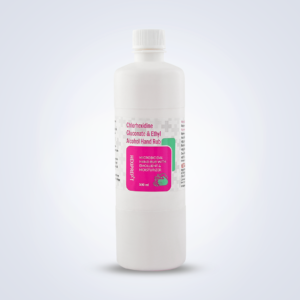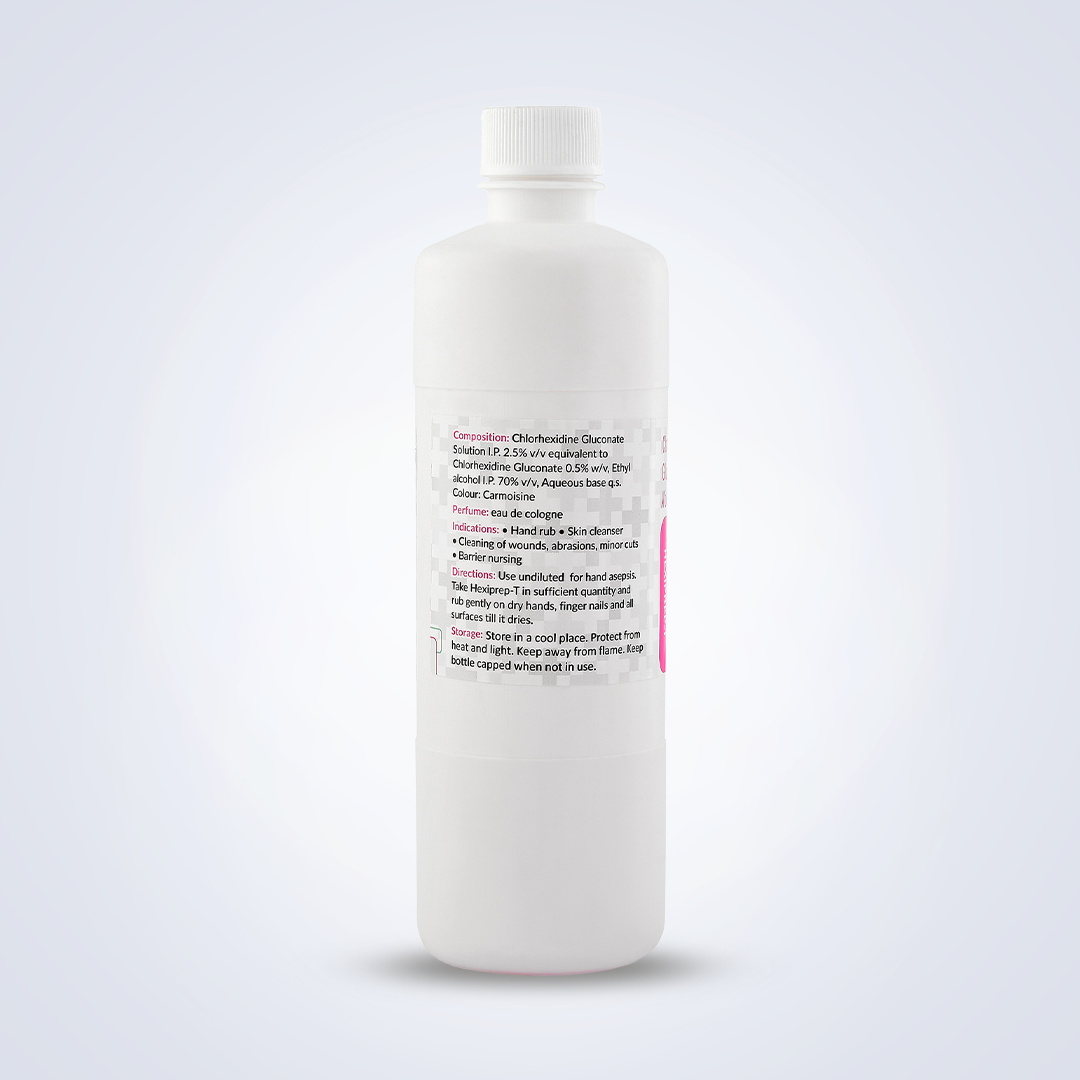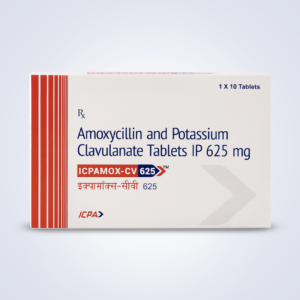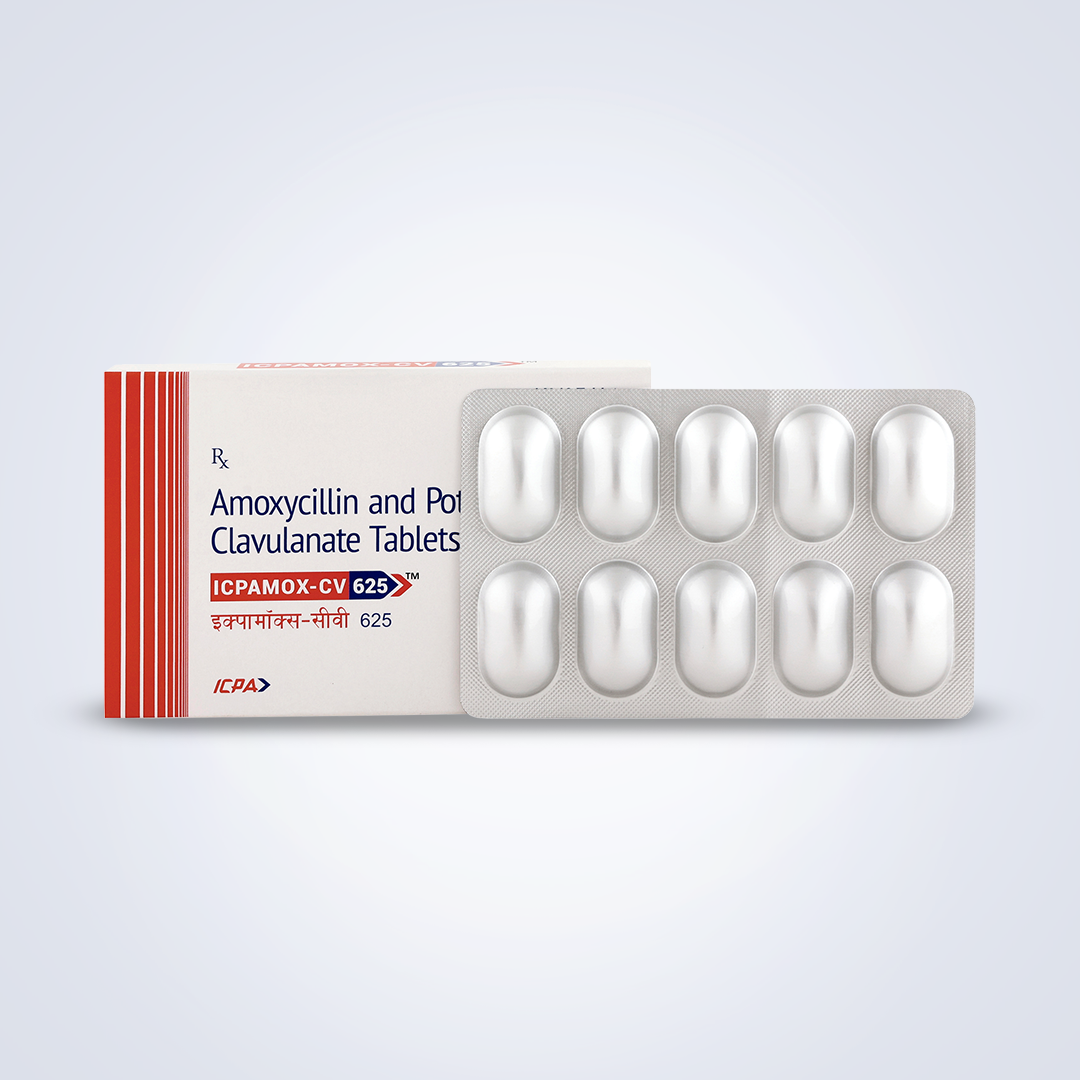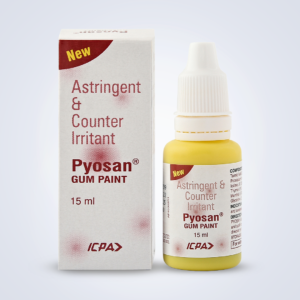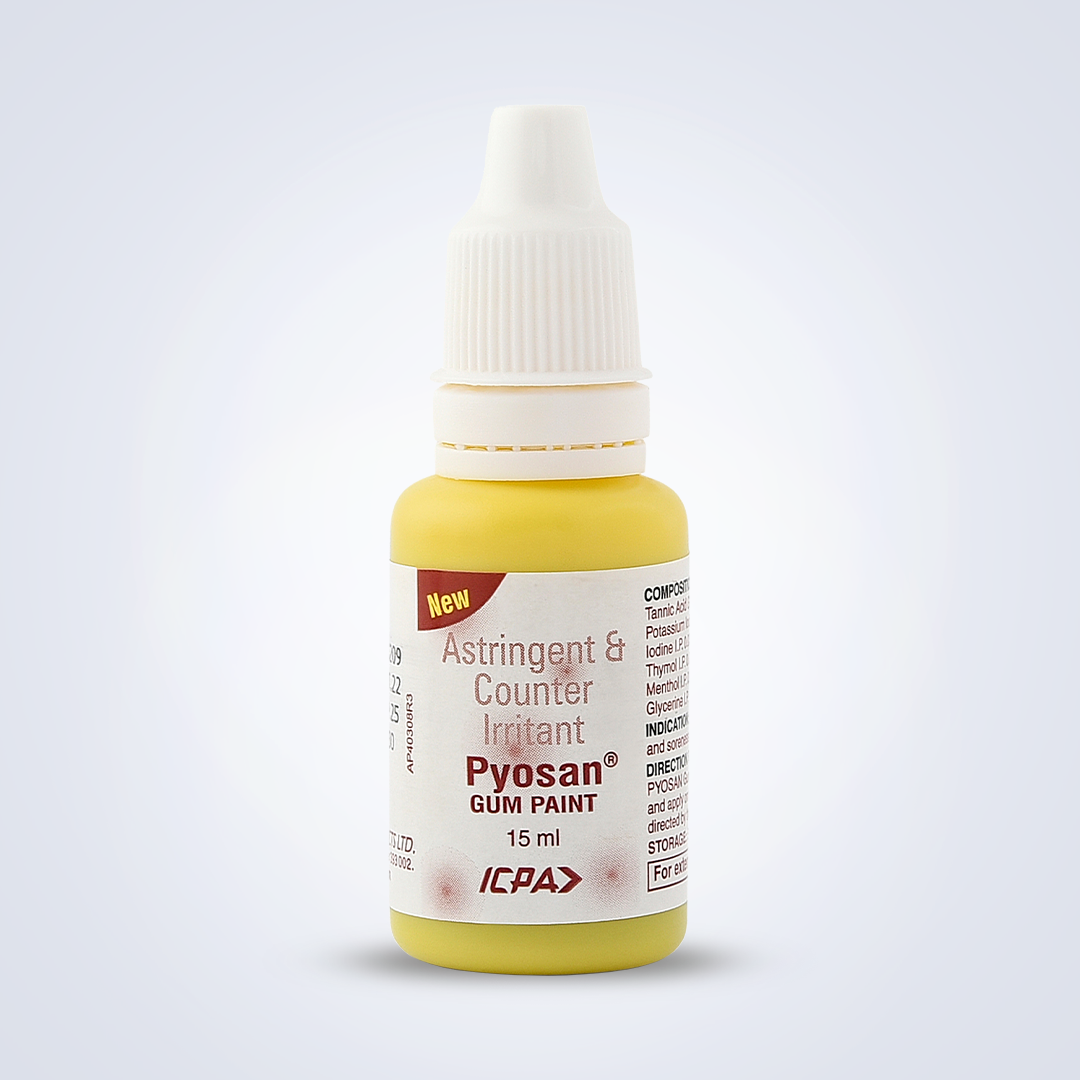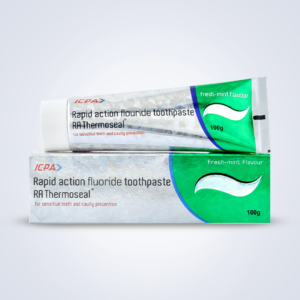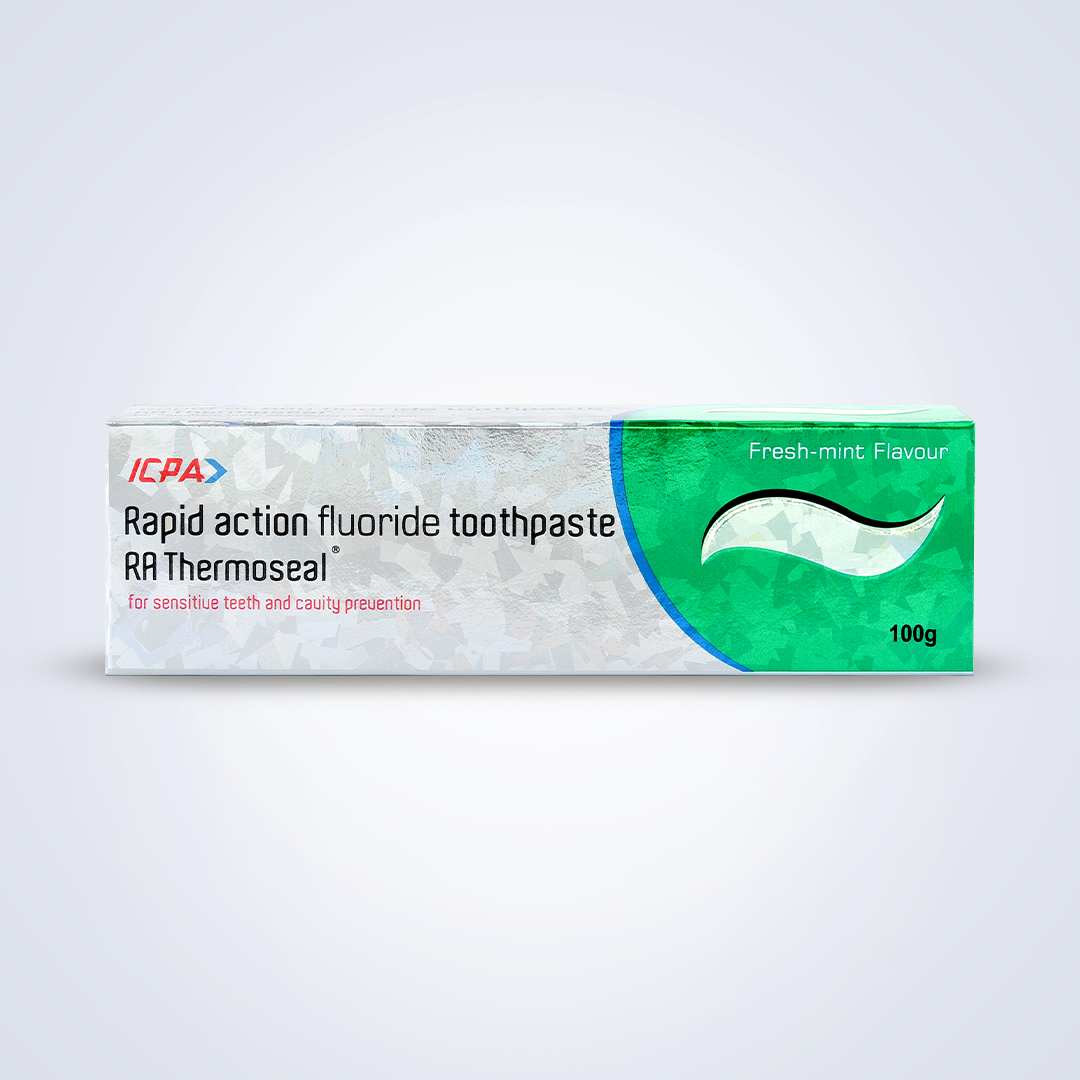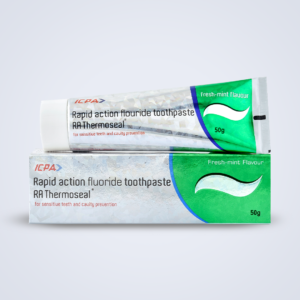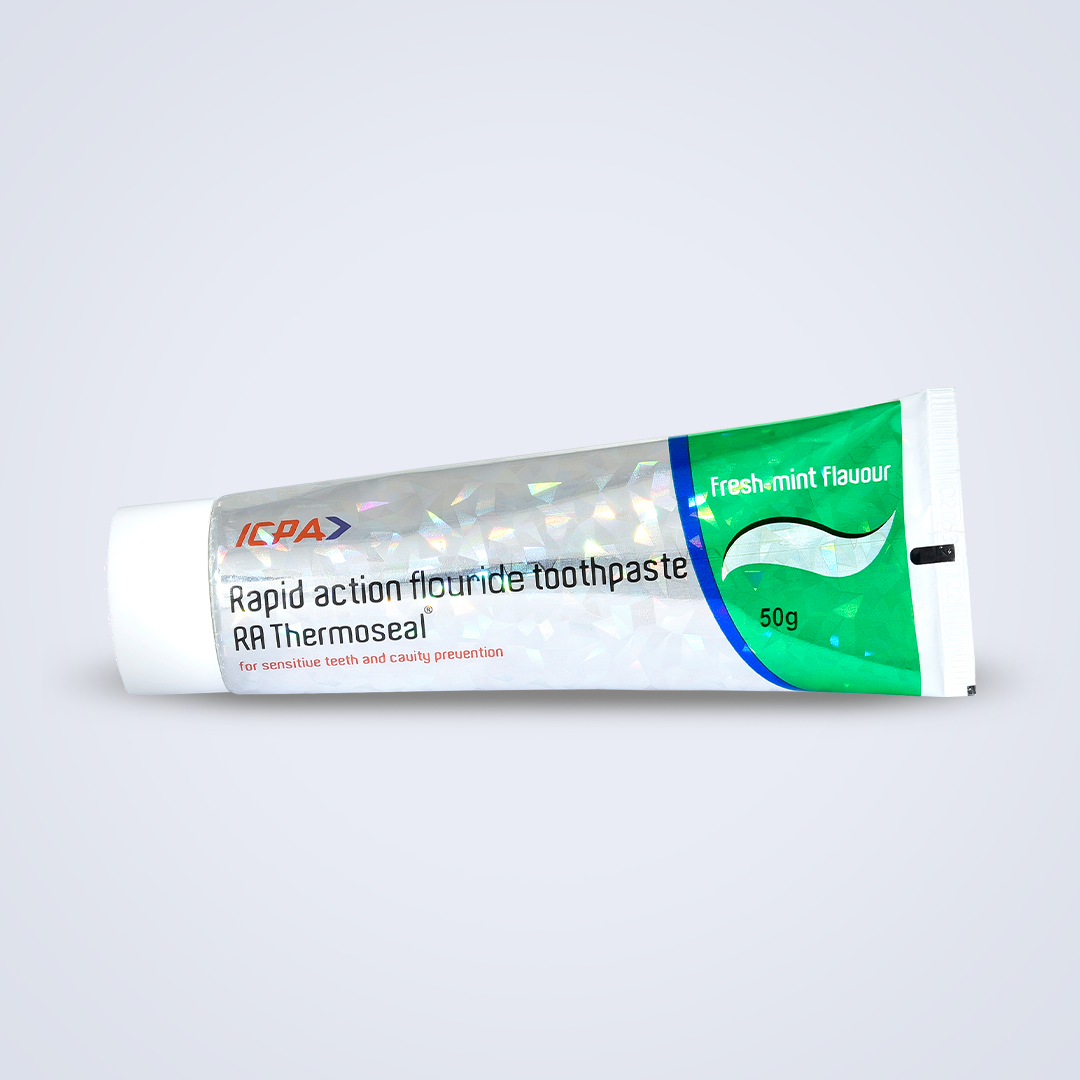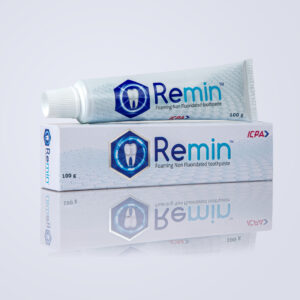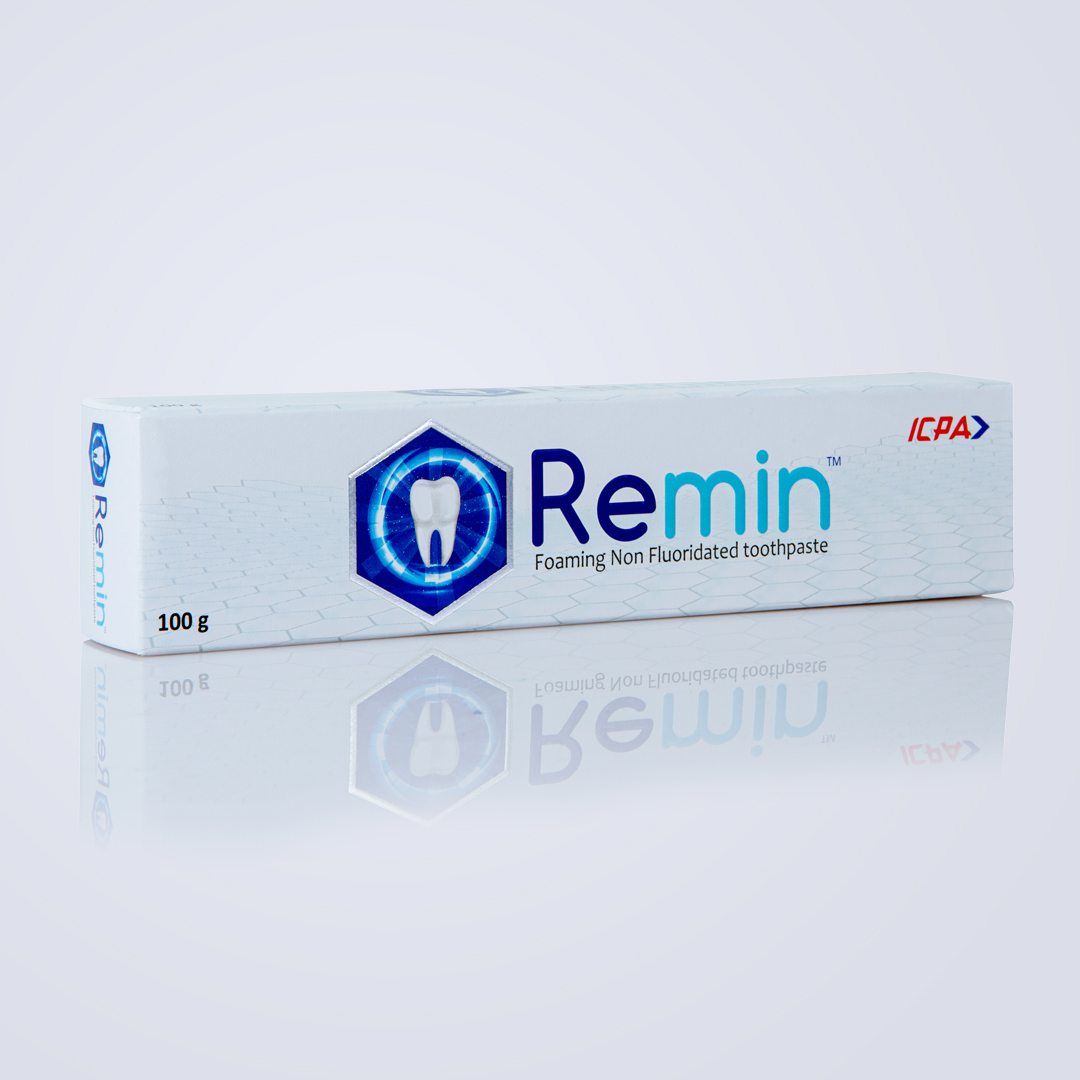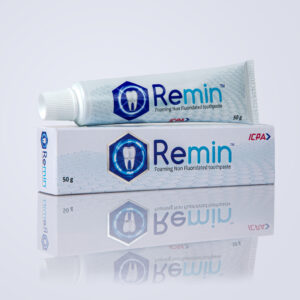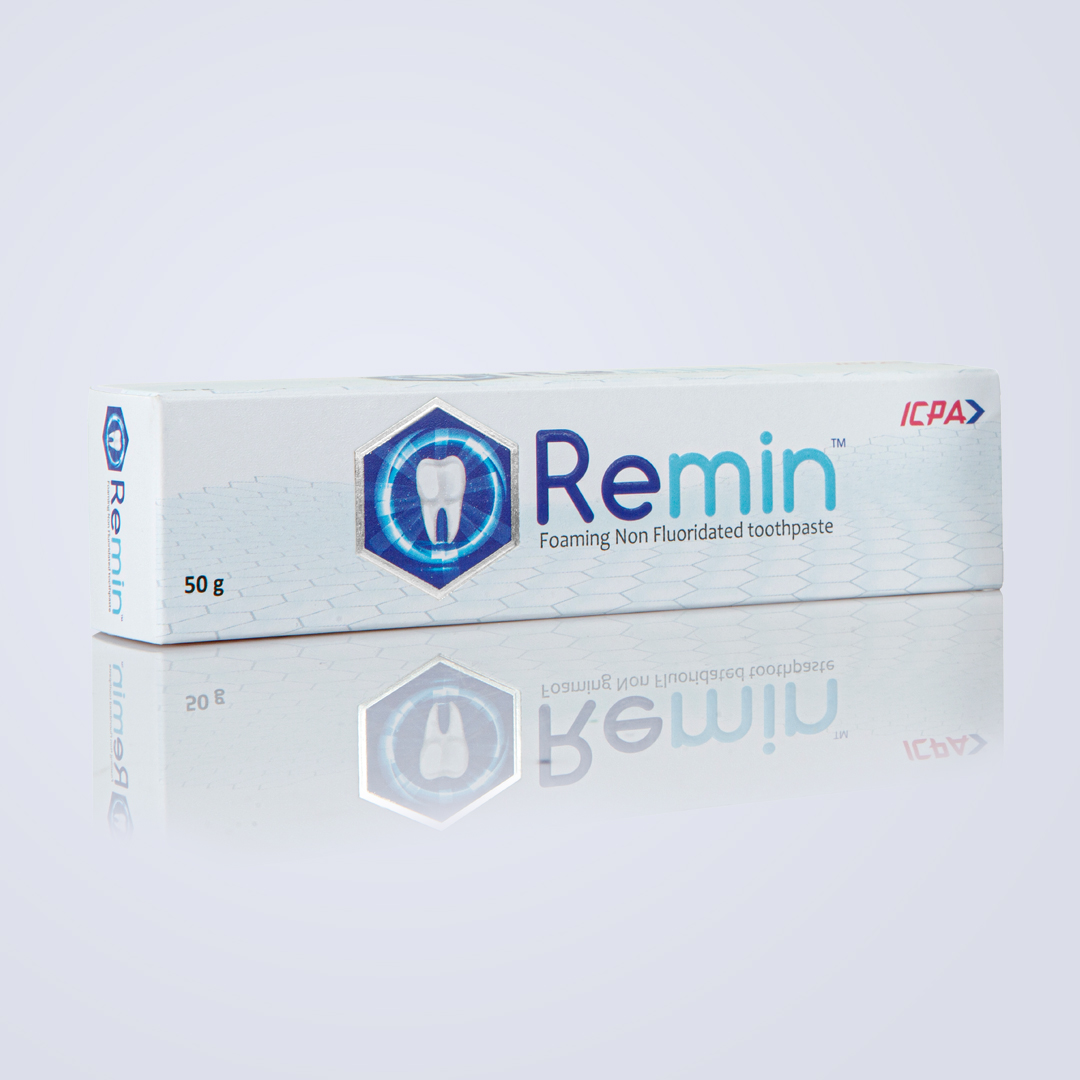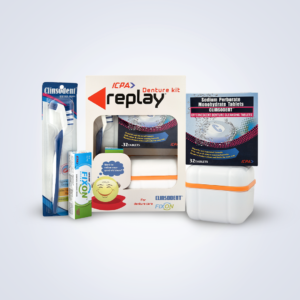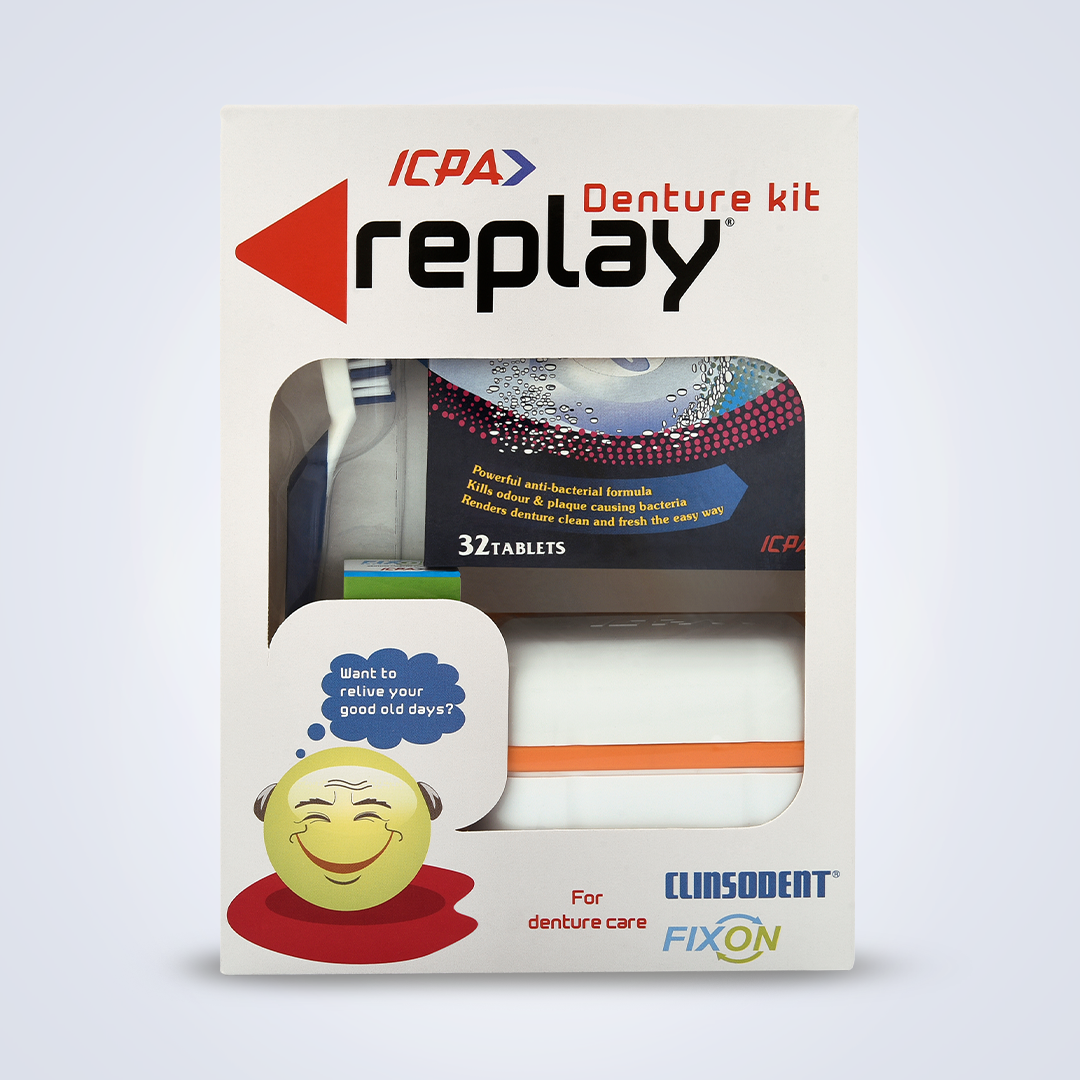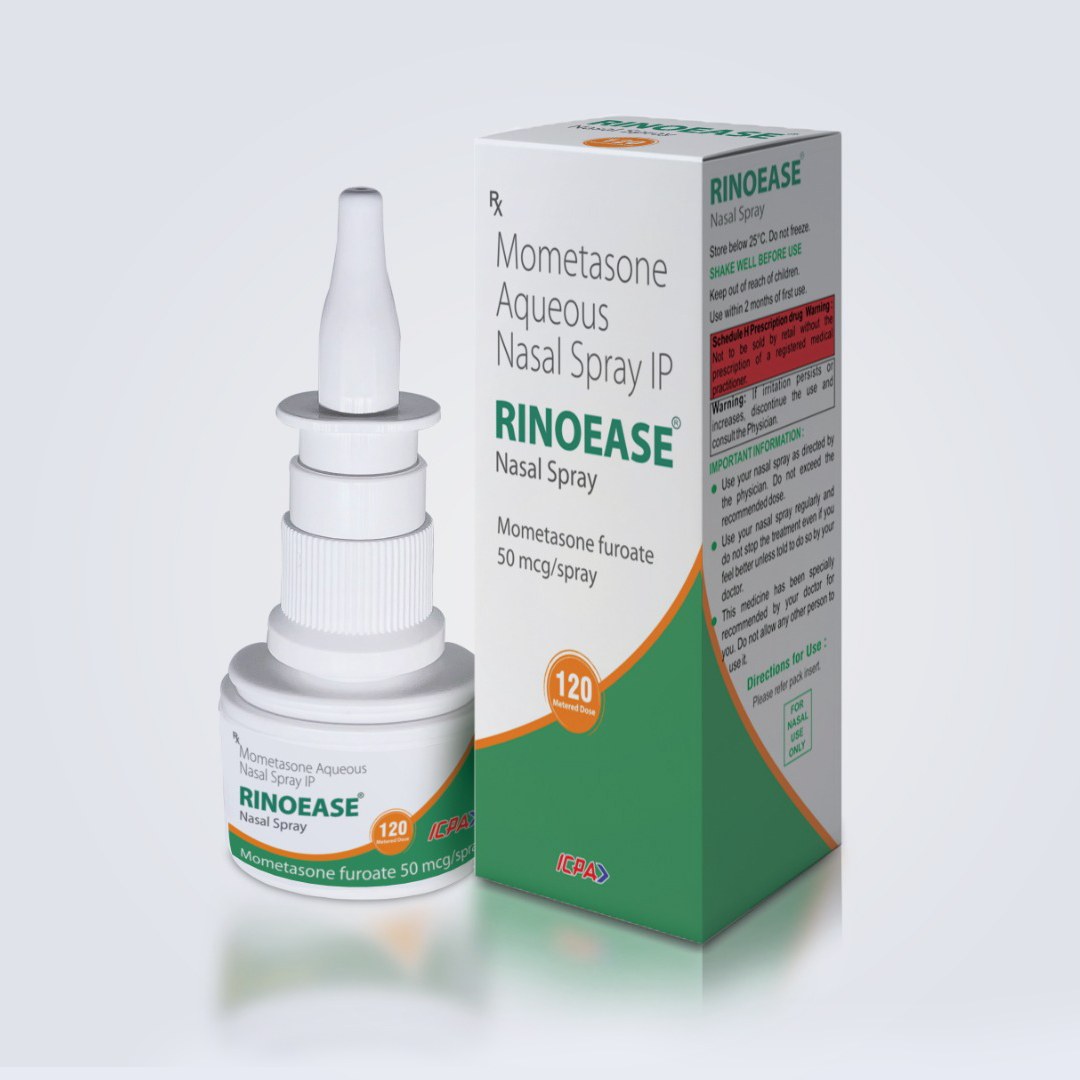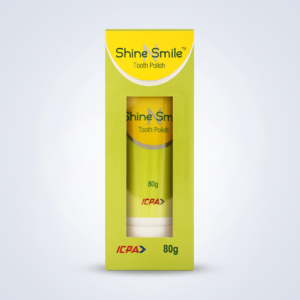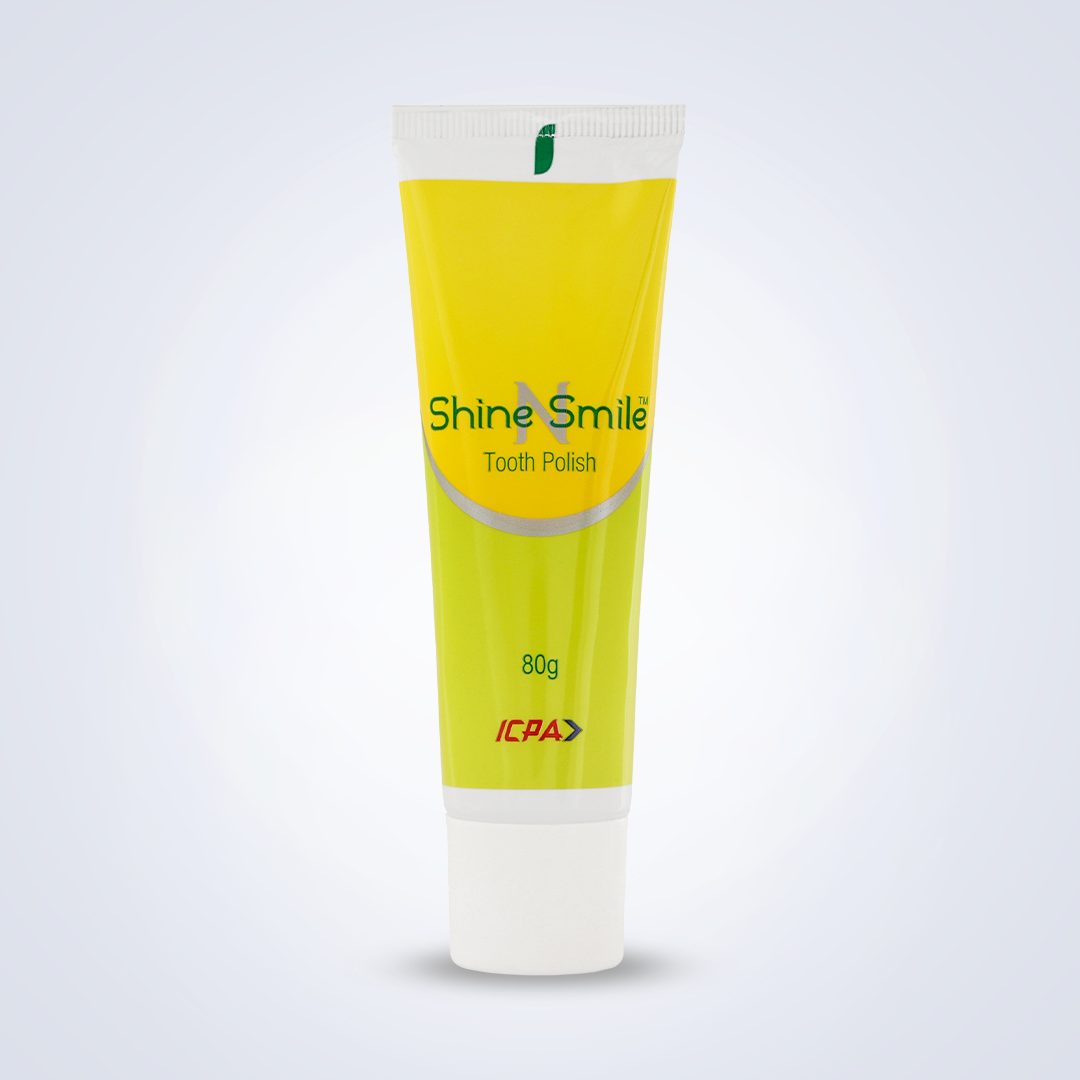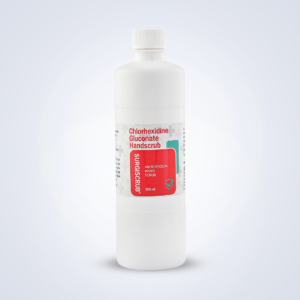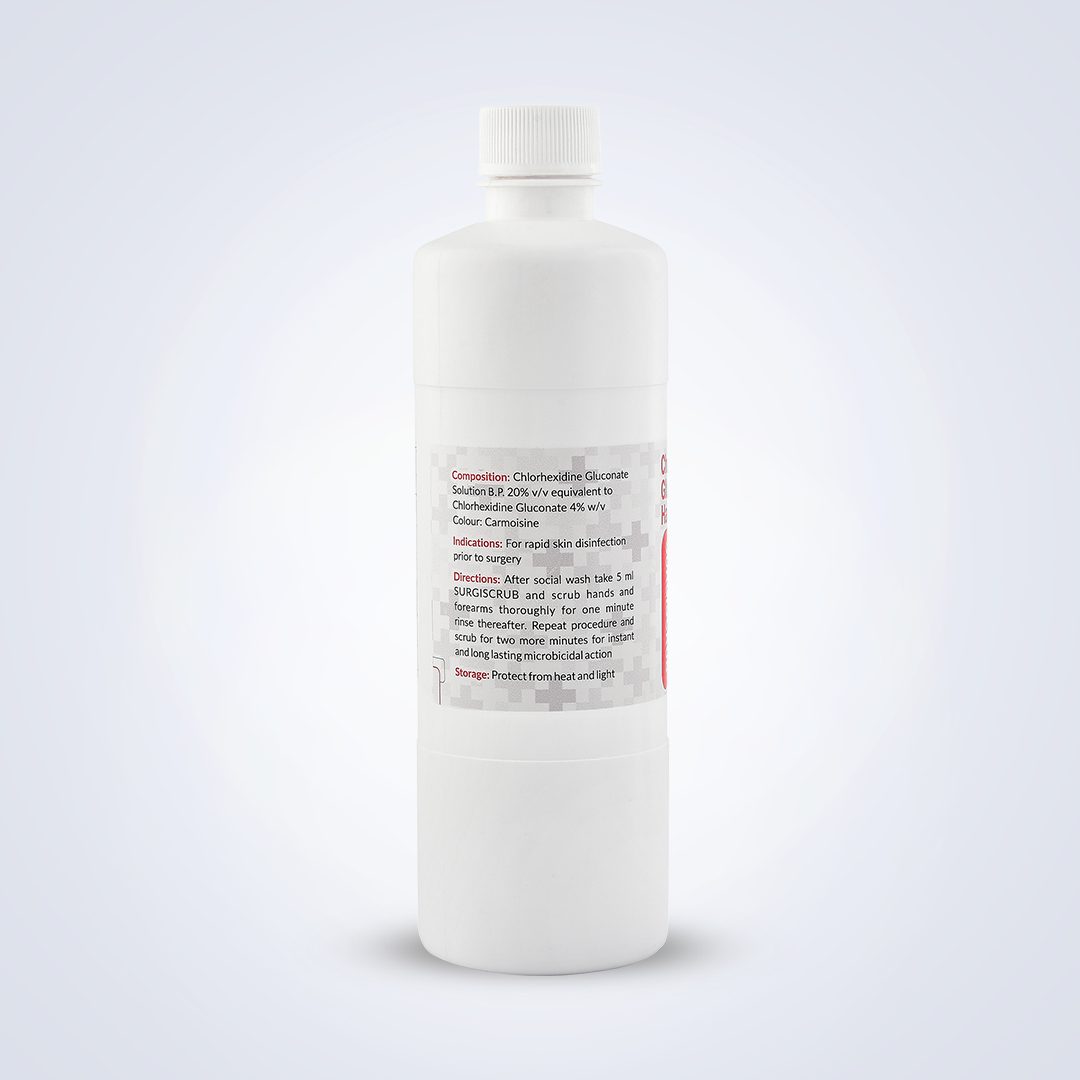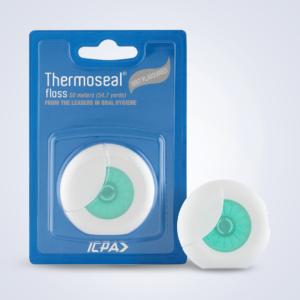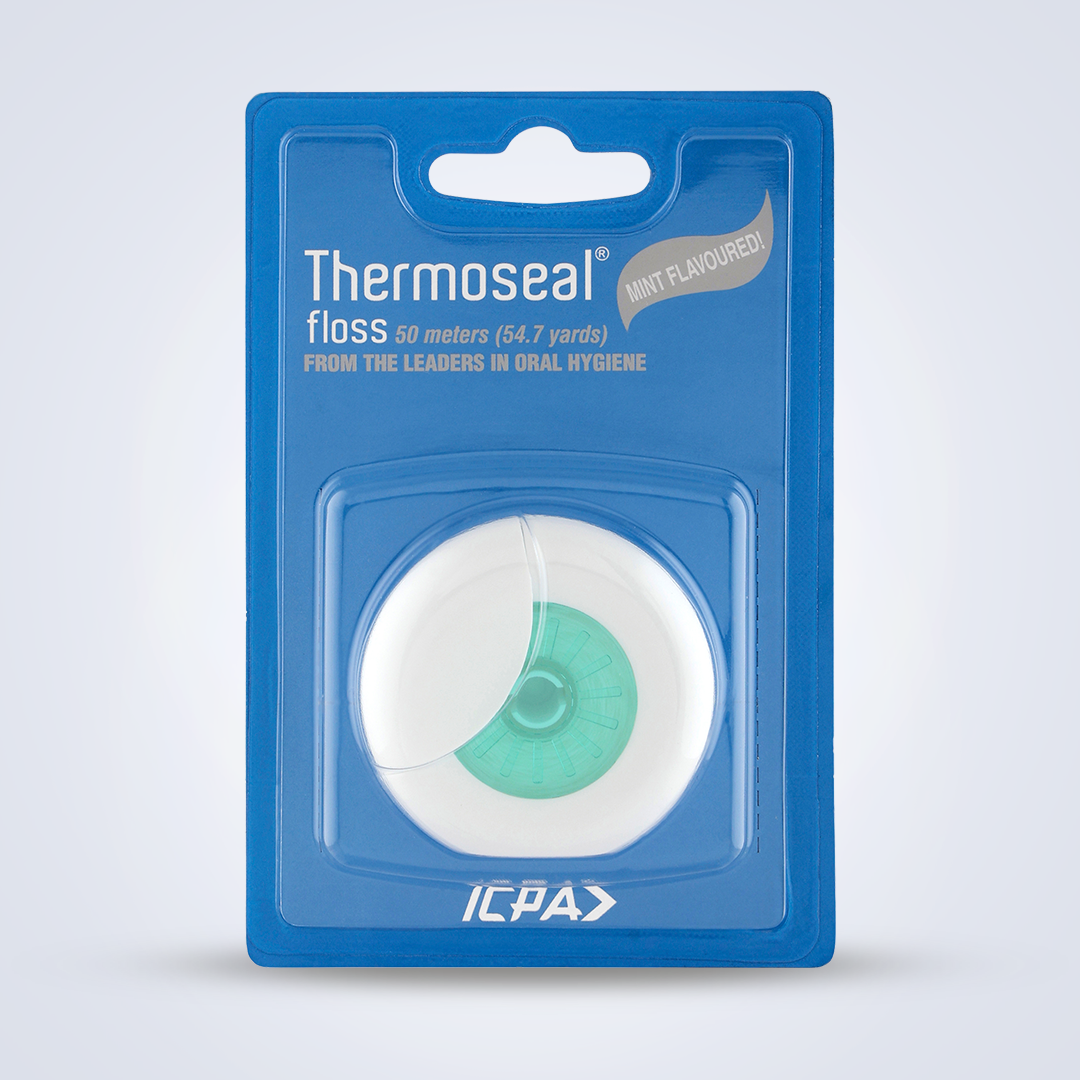Dental Products
Dental Products
Showing 13–24 of 35 results
-
Hexiprep T 500ml
Read More Quick ViewMicrobicidal Hand Rub
Composition:
Chlorhexidine Gluconate Solution 2.5% v/v, equivalent to Chlorhexidine Gluconate 0.5% w/v in aqueous base. Ethyl Alcohol 70% v/v Perfume: eau de Cologne (Formulation available – I.P. – Domestic, B.P. – Export)
Mode of Action:
15 seconds contact microbicidal 12 hours skin binder.
Indications:
Hand Rub Skin Cleanser Cleaning of wounds, abrasions, minor cuts Barrier Nursing.
Directions for use:
Use undiluted for hand asepsis. Take Hexiprep-T in sufficient quantity and rub gently on dry hands, fingernails, and all surfaces, till it dries.
Storage:
Protect from heat and light. Keep away from flame Keep bottle capped when not in use.
Caution:
Keep away from eyes and children For external use only.
Presentation:
Plastic bottle of 500ml (16.9 fl. oz), with a pump
-
ICPAMOX-CV
Read More Quick ViewComposition:
Amoxycillin 500mg + Clavulanic acid 125mg Tablet
Introduction:
ICPAMOX-CV 625 is an antibiotic with broad-spectrum activity against the commonly occurring bacterial pathogens involved in the infections of the oral cavity and other parts of the body. The beta-lactamase inhibitory action of clavulanic acid extends the spectrum of Amoxycillin to act against a wider range of organisms, including many resistant to other beta-lactam antibiotics.
Indications:
ICPAMOX-CV improves treatment success rate in,
1. Acute periapical abscess; along with endo treatment
2. Before starting endo treatment; to reduce post-operative pain
3. Tooth extraction & other oral surgeries; to reduce post-operative infection and bacteremia
4. Before wisdom tooth surgeries; to prevent post-operative infection & dry socket
5. Pericoronitis & Peri-implantitis
6. Periodontitis (as an adjunct to scaling & root planing), periodontal surgeries, periodontal abscess.
7. Facial cellulitisDose:
One tablet BID for 3-7 Days.
Presentation:
Alu Alu blister pack of 10 tablets
Common side effects:
- Diarrhea
- Stomach upset
- Nausea and vomiting
- Mild skin rash
-
Pyosan Gum Paint 15ml
Read More Quick ViewComposition:
Tannic Acid 72%: Astringent
Glycerine 27%: Base for tannic acid
Iodine I.P. 0.03%: Counter-irritant and disinfectant
Potassium iodide I.P. 0.05%: Stabilizer for iodine
Menthol I.P. 0.05%: Mild anaesthetic and Rubifacient
Thymol I.P. 0.033%: Disinfectant and RubifacientCounterirritants and rubefacients
Counterirritants and rubefacients are substances used in periodontology and dentistry to alleviate pain and discomfort associated with oral conditions. They work by producing localized irritation or a sensation of heat on the skin or mucous membranes, which can help distract from or relieve pain.
Counterirritants:
Counterirritants are substances or agents that are applied topically to the skin or mucous membranes in the oral cavity. These substances create a mild irritation, which draws blood and immune system responses to the affected area, effectively diverting attention away from the original source of pain or discomfort. In periodontology, counterirritants may be used to alleviate pain associated with conditions like gingivitis, periodontitis, or oral ulcers.
Rubefacients:
Rubefacients are substances that produce a localized increase in blood flow and redness of the skin or mucous membranes when applied. In the context ofperiodontology, rubefacients may be used to increase blood flow to an area, which can help reduce inflammation and alleviate pain.
Mode of action:
Bleeding gums & pus discharge are a sign of poor oral hygiene and have to be treated symptomatically by a dentist. Astringents help to stop the bleeding & pus discharge of gums, by coagulating proteins. Iodine & Menthol will act as counterirritant & rubefacient and provide relief from itching & irritation. Menthol will additionally provide comfort to the patient.
Indication:
Inflamed sore gums/spongy gums
Directions for use:
Take Pyosan gum paint on the fingertip and apply on the affected gum.
Storage:
Store in cool, dark place.
Caution:
For external use only.
Presentation:
Plastic bottle of 15ml (0.5 fl. oz) with inbuilt dropper.
-
RA Thermoseal 100gm
Read More Quick ViewToothpaste for Dental Hypersensitivity
Composition:
Potassium Nitrate 5% w/w in toothpaste/gel base. Sodium monofluorophosphate 0.7% w/w (available fluoride content 917 ppm when packed).Mode of Action:
Dentinal hypersensitivity is a sharp pain produced in the teeth-, in response to stimuli, such as cold, heat, sweet, sour, or contact. It affects the quality of life and results in extreme discomfort or inability to eat or drink certain foods. It is caused due to opening of the dentinal tubules, after the enamel has been removed by factors such as attrition, abrasion, erosion, or gum recession. RA Thermoseal provides relief from dentinal pain by forming a neurosensory block. Fluoride provides cavity protection. It reduces the demineralization of enamel and dentin by decreasing the acid production of bacterial plaque and decreases the solubility of apatite crystals. It readily becomes incorporated as fluoroapatite layer, to reduce the dissolution of apatite during acid attacks.Indication:
Dentinal hypersensitivity.Directions:
Adults and children over 12 years of age should apply at least 2.5 cm (1”) strip of the product to a soft bristle toothbrush. Brush teeth to clean all surfaces thoroughly with RA Thermoseal toothpaste/gel at least twice a day (morning and evening), or as recommended by a dentist or doctor. Make sure to brush sensitive areas for a longer time.Uses:
- Builds increasing protection against sensitivity of teeth to cold, heat, acids, sweets or contact.
- Helps in the prevention of dental cavities.
Warnings:
For usage beyond 4 weeks, please consult a dentist or doctor. Keep out of reach of children under 6 years of age. Stop use and ask a dentist if the problem persists or worsens.Presentation:
Lamitube of 50g (1.76 oz) / 100g (3.52 oz), Gel in lamitube of 100g (3.52 oz). -
RA Thermoseal 50gm
Read More Quick ViewComposition:
Potassium Nitrate 5% w/w in toothpaste/gel base. Sodium monofluorophosphate 0.7% w/w (available fluoride content 917 ppm when packed).
Understanding the tooth structure:
For an effective management of dentinal hyprsensitivity, it is essential to understand the tooth structure and the roles of enamel, dentin, and pulp, as well as how they contribute to or are affected by tooth sensitivity.
1. Enamel:
a. Enamel is the outermost layer of the tooth, and it is the hardest and most mineralized tissue in the human body.
b. Enamel serves as a protective shield for the more sensitive inner layers of the tooth, primarily dentin and pulp.
c. It is a non-living tissue and is devoid of nerve endings, which means it does not transmit pain or sensations.2. Dentin:
a. Dentin is located beneath the enamel and makes up the bulk of the tooth structure.
b. It is a living tissue, containing microscopic tubules that extend from the outer surface of the dentin (adjacent to the enamel or cementum) to the pulp chamber in the center of the tooth.
c. These dentinal tubules house nerve endings and fluid-filled channels, connecting to the dental pulp.
d. Dentin is responsible for transmitting sensations or pain to the pulp when it is stimulated by external factors.3. Pulp:
a. The pulp is the innermost portion of the tooth, residing in the pulp chamber and extending into the root canals.
b. It contains vital components like blood vessels, nerves, and connective tissues.
c. The pulp is responsible for nourishing and maintaining the tooth, as well as detecting and responding to external stimuli.
d. When dentin is exposed or irritated due to factors like enamel erosion, gum recession, or tooth decay, the pulp may transmit pain signals, causing tooth sensitivity.In relation to tooth hypersensitivity:
- Enamel erosion or loss can expose the underlying dentin to external stimuli, which can lead to hypersensitivity. Enamel acts as a protective barrier, and when it is compromised, it can no longer shield the dentin from temperature changes, acidic foods, or pressure.
- Dentin, with its tubules and nerve endings, is the primary culprit in tooth sensitivity. When the dentinal tubules are open or exposed, they can transmit sensations and pain to the pulp, causing discomfort or sharp pain.
- The pulp is the nerve center of the tooth, and it plays a crucial role in sensing and responding to external stimuli. When it receives signals from the dentin due to hypersensitivity, it may trigger pain responses, leading to the discomfort associated with sensitive teeth.
In summary, enamel protects the inner tooth structures, dentin contains the nerve endings responsible for tooth sensitivity, and the pulp is the central nervous system of the tooth that responds to external stimuli. Understanding the roles of these tooth structures is important in managing and addressing hypersensitivity.
Dentinal hypersensitivity (Sensitive teeth)
Dentinal hypersensitivity, also known as tooth sensitivity or sensitive teeth, is a common dental condition where an individual experiences short sharp pain arising from exposed dentin in response to stimuli, typically thermal, evaporative, tactile, osmotic, or chemical, and which cannot be ascribed to any other form of dental defect or pathology. This discomfort typically originates from the dentin, which is the inner layer of the tooth, lying beneath the protective enamel and cementum.
Common triggers:
Dentin contains tiny tubules that connect to the nerve endings in the dental pulp, and when these tubules are exposed or stimulated, it can lead to tooth sensitivity. Common triggers for dentinal hypersensitivity include:
1. Hot or cold foods and beverages.
2. Sweet or sour foods.
3. Cold air or cold water exposure.
4. Brushing or flossing teeth.
5. Pressure from biting or chewing.Etiology:
There are several potential causes of dentinal hypersensitivity, including:
1. Tooth enamel erosion: Enamel is the outermost layer of the tooth, and if it wears away due to factors like acid erosion from acidic foods or beverages, tooth grinding (bruxism), or aggressive toothbrushing, it can expose the dentin.
2. Gum recession: When the gum tissue recedes, it exposes the tooth roots, which are not protected by enamel. The dentin on these exposed areas is more susceptible to sensitivity.
3. Tooth decay or cavities: If cavities form and progress to the dentin, it can cause sensitivity.
4. Cracked or chipped teeth: These can create pathways for stimuli to reach the dentin, causing sensitivity.Management of dentinal hypersensitivity:
To manage dentinal hypersensitivity, individuals can try various approaches, including:
1. Using desensitizing toothpaste: Special toothpaste formulations contain compounds like potassium nitrate or fluoride that can help block the tubules in the dentin, reducing sensitivity.
2. Avoiding acidic and abrasive foods: Minimizing consumption of acidic foods and drinks and using a soft-bristle toothbrush can help prevent further enamel erosion.
3. Good oral hygiene: Maintaining regular oral hygiene practices, such as proper brushing and flossing, can prevent the development of cavities and gum disease.
4. Dental treatments: In some cases, a dentist may recommend treatments like fluoride varnishes, bonding, or dental sealants to address sensitivity.It’s essential to consult a dentist if you experience persistent or severe dentinal hypersensitivity to determine the underlying cause and receive appropriate treatment. Your dentist can provide guidance on managing and addressing your specific condition.
Mode of Action:
RA Thermoseal provides relief from dentinal pain by forming a neurosensory block. Fluoride ensures tooth surface remineralization. It reduces the demineralization of enamel and dentin by decreasing the acid production of bacterial plaque and decreases the solubility of apatite crystals. It readily becomes incorporated as fluoroapatite layer, to reduce the dissolution of apatite during acid attacks.
Potassium Nitrate and Sodium Monofluorophosphate based toothpastes are recommended by the standard textbooks as the first line treatment for dentinal hypersensitivity.
Indications:
1. Patients complaining of sensitive teeth. (Dentinal hypersensitivity).
2. Post-scaling sensitivity.
3. In tooth whitening treatments. Patients can start RA Thermoseal 2 weeks before the tooth whitening appointment.Directions:
Adults and children over 12 years of age should apply at least 2.5 cm (1”) strip of the product to a soft or ultrasoft bristle toothbrush. Brush teeth to clean all surfaces thoroughly with RA Thermoseal toothpaste/gel at least twice a day (morning and evening), or as recommended by a dentist or doctor. Make sure to brush sensitive areas for a longer time.
Uses:
1. Builds increasing protection against sensitivity of teeth to cold, heat, acids, sweets or contact.
2. Helps in the prevention of dental cavities.Warnings:
For usage beyond 4 weeks, please consult a dentist or doctor. Keep out of reach of children under 6 years of age. Stop use and ask a dentist if the problem persists or worsens.
Presentation:
Lamitube of 50g (1.76 oz) / 100g (3.52 oz), Gel in lamitube of 100g (3.52 oz).
-
Remin 100gm
Read More Quick View1. Composition – Calcium sodium phosphosilicate 5%
2. Mode of Action – The reaction of Bioactive Glass particles begins when the material is subjected to an aqueous environment.
- Bioactive glass is made up of amorphous Calcium-sodium- phosphosilicate (CSPS).
- CSPS is highly reactive in aqueous environments, such as saliva in the oral cavity.
- The exposure to saliva leads to the release of Sodium ions from the bioactive glass.
- In saliva, sodium ions from the bioactive glass readily react with salivary hydrogen cations (H3O+) resulting in a localized, transient increase in pH.
- Increased pH leads to the release of calcium, phosphate, and silica ions forming a robust HA-like layer
3. Indications – To promote tooth surface remineralization (esp. White Spot Lesions) and prevent Tooth Surface Loss (demineralization) under acid attack.
- To promote enamel remineralization and reverse ongoing enamel demineralization caused by acidic diets and carious bacterial acids.
- For daily remineralization of dental white spot lesions (WSL) during orthodontic treatment.
- For daily remineralization of dental white spot lesions (WSL) in people prone to dental caries.
- To seal dentinal tubules on exposed dentine surfaces, creating a stable seal even under acid attack— to prevent and ensure long-term relief from dentinal hypersensitivity.
- Daily tooth surface remineralization before meals for patients with acid erosion (e.g., gastritis, reflux, GERD).
- To remineralize and strengthen the tooth surfaces before, during, and after tooth whitening procedures.
4. Directions
- Brush twice daily.
- Spit out and do not swallow.
- Close the cap after each use.
5. Uses – Foaming non-fluoridated toothpaste, for dental use only
6. Warning – storage below 30° c
7. Presentation- 50 g and 100 g -
Remin 50gm
Read More Quick View1. Composition – Calcium sodium phosphosilicate 5%
2. Mode of Action – The reaction of Bioactive Glass particles begins when the material is subjected to an aqueous environment.
- Bioactive glass is made up of amorphous Calcium-sodium- phosphosilicate (CSPS).
- CSPS is highly reactive in aqueous environments, such as saliva in the oral cavity.
- The exposure to saliva leads to the release of Sodium ions from the bioactive glass.
- In saliva, sodium ions from the bioactive glass readily react with salivary hydrogen cations (H3O+) resulting in a localized, transient increase in pH.
- Increased pH leads to the release of calcium, phosphate, and silica ions forming a robust HA-like layer
3. Indications – To promote tooth surface remineralization (esp. White Spot Lesions) and prevent Tooth Surface Loss (demineralization) under acid attack.
- To promote enamel remineralization and reverse ongoing enamel demineralization caused by acidic diets and carious bacterial acids.
- For daily remineralization of dental white spot lesions (WSL) during orthodontic treatment.
- For daily remineralization of dental white spot lesions (WSL) in people prone to dental caries.
- To seal dentinal tubules on exposed dentine surfaces, creating a stable seal even under acid attack— to prevent and ensure long-term relief from dentinal hypersensitivity.
- Daily tooth surface remineralization before meals for patients with acid erosion (e.g., gastritis, reflux, GERD).
- To remineralize and strengthen the tooth surfaces before, during, and after tooth whitening procedures.
4. Directions
- Brush twice daily.
- Spit out and do not swallow.
- Close the cap after each use.
5. Uses – Foaming non-fluoridated toothpaste, for dental use only
6. Warning – storage below 30° c
7. Presentation- 50 g and 100 g -
Replay Kit
Read More Quick ViewDenture Management Kit consisting of Denture Storewell, Clinsodent Tablets, Clinsodent Brush and Fixon Denture Adhesive Cream.
CLINSODENT® DENTURE BRUSH
Hygienically designed – No seams where dirt can get trapped.
2 types of nylon bristles designed to clean all surfaces and grooves.Contoured design – Maximises control of brushing. Ambidexterity – Works in right or left hand.
CLINSODENT® TABLETS
EFFERVESCENT DENTURE CLEANSING TABLETSFIXON CREAM
DENTURE ADHESIVE CREAM -
Rinoease Nasal Spray
Read More Quick ViewDOSAGE FORM: Aqueous intranasal spray For use by adults and children 12 years and over.
DESCRIPTION: Mometasone aqueous nasal spray is a synthetic trifluorinated corticosteroid with potent anti-inflammatory activity. The precise mechanism through which Mometasone Furoate affects rhinitis symptoms is not known.
INDICATIONS: Seasonal Allergic or Perennial Rhinitis, Nasal polyposis, Acute Rhinosinusitis, Adjunctive treatment of acute episodes of sinusitis. Mometasone Aqueous Nasal spray is indicated for the treatment of the
symptoms of seasonal and perennial allergic rhinitis in patients aged 12 years and older.DOSAGE AND ADMINISTRATION :
Adult and Adolescents (12 years of age and older): The recommended starting dosage is 2 sprays in each nostril once daily. When the maximum benefits have been achieved and symptoms have been controlled, reducing the dosage to 1 spray in each nostril once daily may be effective in maintaining control of allergic rhinitis symptoms. Children (2 to 11 Years of Age): As advised by the physician.ADMINISTRATION: Before administration of the first dose, shake the container well and actuate the pump 10 times (until a uniform spray is obtained). If the pump is not used for 14 days or longer, reprime the pump with 2 actuations until a uniform spray is observed before the next use.
CONTRAINDICATIONS: Mometasone Aqueous Nasal spray is contraindicated in patients with a hypersensitivity to Mometasone furoate or any of the ingredients.
WARNING AND PRECAUTIONS :
1. Use in pregnancy and lactation: Mometasone Aqueous nasal spray should be used during pregnancy only if the potential benefits justify the potential risk to the fetus.
2. Hypoadrenalism may occur in infants born to mothers receiving corticosteroids during pregnancy. Such infants should be carefully monitored. Since there is no data from controlled trials on the use of intranasal Mometasone Aqueous by nursing mothers, caution should be exercised when Mometasone Aqueous nasal spray is administered to a nursing mother.
3. Use in hepatic and renal impairment: Since Mometasone Furoate undergoes extensive first-pass metabolism by the hepatic cytochrome P450 isozyme, CYP3A4, the pharmacokinetics of Mometasone Furoate may be altered in patients with hepatic impairment. Therefore, use Mometasone Aqueous nasal spray with caution in patients with severe hepatic impairment. No dosage adjustment is required in patients with renal impairment.UNDESIRABLE EFFECTS:
The most common adverse events reported with Mometasone Furoate use are headache, epistaxis, pharyngolaryngeal pain, nasal ulceration, back pain, pyrexia headache, epistaxis, pharyngolaryngeal pain, nasal ulceration, back pain, pyrexia and coughPRESENTATION :
Plastic bottle with spray pump and over cap – 120 metered doses/pack.IMPORTANT INFORMATION :
1. Use your nasal spray as directed by the physician. Do not exceed the recommended dose.
2. Use your nasal spray regularly and do not stop the treatment even if you feel better unless told to do so by your doctor.
3. This medicine has been specially recommended by your doctor for you. Do not allow any other person to use itSTORAGE :
Store below 25°C. Do not freeze.SHAKE WELL BEFORE USE
Keep out of reach of children.
Use within 2 months of first use -
Shine-N-Smile 80gm
Read More Quick ViewComposition:
Mild abrasive with Sodium monofluorophosphate 0.8% fluoride content: 800 ppm, non-foaming
Mode of action:
Dull, yellowish teeth are a source of constant embarrassment to a person. Shine-N-Smile offers a mild abrasive that polishes the teeth and renders them sparkling white.
Indications:
1. Home use: Dull yellowish teeth, mild to moderate stain.
2. Clinic use: As a polishing agent after professional scaling of teeth.Directions for use:
Use in place of regular toothpaste, twice a week only.
Caution:
Should be kept away from children under 12 years. Not to be swallowed.
Storage:
Keep the tube capped when not in use.
Presentation:
Tube of 80gm
-
Surgiscrub 500ml
Read More Quick ViewComposition:
Chlorhexidine Gluconate Solution 20% v/v equivalent to Chlorhexidine Gluconate 4% w/v. (Formulation available I.P. – Domestic, B.P. – Export)
Mode of Action:
15 seconds contact microbicidal 12 hours skin binder
Indications:
For rapid disinfection of hands before surgery. Pre-operative whole body wash. Before treatment of serious burn wounds.
Directions for use:
After social wash, take 5 ml of Surgiscrub. Scrub hands and forearms thoroughly for
1 minute, and wash thereafter. Repeat the procedure and scrub for
2 more minutes,for instant and long-lasting microbicidal action.Caution:
Do not mix with other soap or detergents. For external use only. Do not clean ear cavities.
Storage:
Protect from heat and light.
Presentation:
Plastic bottle of 500ml (16.9 fl.oz).
-
Thermoseal Dental Floss 5..
Read More Quick ViewWaxed dental floss for interdental cleaning, removes plaque and particles from tight contact areas between teeth.
Presentation :
50 meters, waxed, mint flavoured.
Quick Links
Our Products
Information
Contact us
- 216-219, Adarsh Industrial Estate, Sahar Road, Chakala, Andheri (East), Mumbai - 400099
- Fax : 28216928
- +91 22 40065305 / 40065306 / 40065307
- info@icpahealth.com


Selected Icpa Products
Click on Add to cart to add this item in cart.
| PRODUCTS | QTY | PRICE | VALUE in INR |
|---|
Selected Icpa Products
Click on Add to cart to add this item in cart.
| PRODUCTS | QTY | PRICE | VALUE in INR |
|---|

